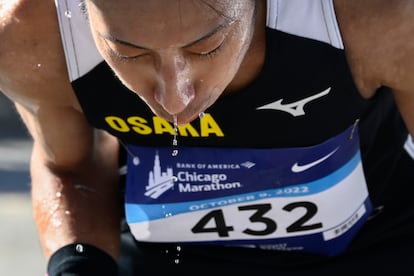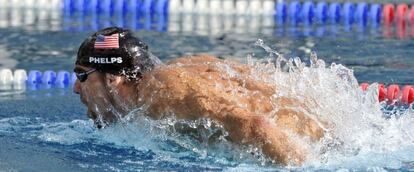How to recover after a workout: Natural methods are as beneficial as supplements
Replenishing nutrients and electrolytes and consuming the right amount of protein and carbohydrates is key to muscle recovery and avoiding weight gain

In recent years, gyms have become a kind of mini-mart for sports nutrition products, with a corner dedicated to protein powders and bars, recovery shakes and all manner of liquids that promise to dramatically enhance performance. The point is that going to a yoga class is not the same thing in terms of exertion as going full tilt in a high-intensity interval training (HIIT) session, or cycling through a couple of mountain passes. They are completely different types of training and require different forms of recovery.
The question many people ask when stating out at the gym or in a sport is whether or not it is necessary to take a processed and packaged recovery product. The answer is simple: no. Despite the claims made by the marketing for these products, carbohydrates, protein and other micronutrients can be restored with normal food and drink. “In fact, I would prioritize natural food and only add supplements if necessary,” says sports nutritionist Andrea Ferrandis. A balanced diet is often better than a post-training strategy, she adds: “The need to eat something specific after training depends on the intensity of the workout: if you do a high-intensity 40-minute workout you need a good recovery strategy; if you do a 90-minute bicycle ride at very low intensity you probably don’t need it.” Frequency is also a factor: if you go to the gym five times a week, a recovery program might be useful. If you go once a week, it’s not really necessary.
Once the necessity factor has been decided, the next question is what and how much? “The correct thing to do after training is to eat carbohydrates, to replenish glycogen reserves, along with protein, to repair the muscles,” says Ferrandis. “This should be in a 2:1 ratio: that is, for every two grams of carbohydrates, we should add one gram of protein.” The famous recovery shakes that many athletes use already contain this exact proportion. But everyday foodstuffs can provide the same thing: rice with chicken or tuna, a plate of vegetables (or hummus), or a ham sandwich. “The important thing is to factor this intake into the total calorie and macronutrient count. It’s not about having a sandwich when you leave the gym and then having a big dinner when you get home.”

The metabolic window
While replacing carbohydrates as soon as possible is advisable (they are like putting gasoline in a car to keep it running), the latest research suggests that proteins can wait a little longer. This is connected to the so-called metabolic window – the period of time in which the body can take in proteins most efficiently. When this window closes, amino acids are less able to synthesize properly. Some experts place this window at up to two hours after exercising. Others limit the window to 30-45 minutes. “Recent studies seem to indicate that protein can be taken several hours after or even before training. However, it is particularly beneficial to do so within the two hours before or after exercise to stimulate muscle recovery as soon as possible,” says nutritionist and dietician Ramón de Cangas.
Chips aren’t the answer to recuperating sodium
When we sweat, we lose electrolytes, above all sodium. However, not everyone sweats in the same way and the sodium composition of the human body also varies. The intensity of the exercise has an influence, but there are other factors including gender (men sweat more than women), age (sweat glands gradually atrophy as we get older), temperature and humidity and even testosterone and cortisone levels. Sodium makes up 50% of a salt molecule, and as such the simple condiment is the primary candidate when it comes to replacing electrolytes lost though sweat. In fact, legislation in Spain states that electrolyte drinks for athletes must contain between 460 and 1,150 mg/l of the mineral to be considered as such. These beverages do not taste salty because they are packed with sugars, in the form of glucose and sucrose, to produce a high glycemic response. Once one of these drinks has been consumed post-exercise, “it doesn’t make sense to consume any more of them,” says nutritionist and author Laura Jorge. “And even less so to eat a bag of chips or pile salt on the rest of your food with the excuse that you’re replacing electrolytes.”
There are homemade alternatives to electrolyte drinks. Nutritionist and dietician Virginia Gómez Sánchez provides one: two and half tablespoons of sugar or honey, half a teaspoon of baking soda, the juice of two lemons or two oranges and a pinch of salt dissolved in a liter of water.
Sugar is ok, but in small doses
As with salt, so with sugar: “Fast sugars, such as glucose, are the best way to replenish glycogen reserves when you finish training. That’s why, in these cases, fruit is not the best option. Fructose, the sugar naturally present in fruit, is absorbed more slowly, among other reasons because of the fruit’s own fiber. So, in this instance, and without serving as a precedent, taking on pure sugar is completely justified. We’re not talking about an excuse to eat cakes here though, we’re talking about a glycogenic drink,” says Ferrandis.
In the case of strenuous exercise, it is necessary to dose sugars so as not to hit the wall, or experience extreme fatigue: Ferrandis, who specializes in setting out diets for professional athletes, notes: “If the activity lasts between one and two-and-a-half hours, you need to take on 30-60 grams of carbohydrates. For anything over that timescale, the dose will be 90 grams per hour. There is no need to consume even an excess gram of sugar.”

If you’re not Michael Phelps, don’t try to eat like him
Post-training intake should be administered in accordance with the specific energy needs of the individual. Generally speaking, we tend to overestimate the energy we burn during a workout and underestimate the restorative effects of food and drink. A person weighing 70 kilograms (154 pounds) will burn around 600 calories in a one-hour spin class. Believing that giving it our all in an exercise of this kind means that we should try and emulate Michael Phelps at the 2008 Olympic Games, where the American multi-gold medal winner consumed 12,000 calories a day, can lead to a calorie intake far higher than required. Training hard and putting on weight is something that happens more frequently than people may think.
Tu suscripción se está usando en otro dispositivo
¿Quieres añadir otro usuario a tu suscripción?
Si continúas leyendo en este dispositivo, no se podrá leer en el otro.
FlechaTu suscripción se está usando en otro dispositivo y solo puedes acceder a EL PAÍS desde un dispositivo a la vez.
Si quieres compartir tu cuenta, cambia tu suscripción a la modalidad Premium, así podrás añadir otro usuario. Cada uno accederá con su propia cuenta de email, lo que os permitirá personalizar vuestra experiencia en EL PAÍS.
¿Tienes una suscripción de empresa? Accede aquí para contratar más cuentas.
En el caso de no saber quién está usando tu cuenta, te recomendamos cambiar tu contraseña aquí.
Si decides continuar compartiendo tu cuenta, este mensaje se mostrará en tu dispositivo y en el de la otra persona que está usando tu cuenta de forma indefinida, afectando a tu experiencia de lectura. Puedes consultar aquí los términos y condiciones de la suscripción digital.
More information
Últimas noticias
Most viewed
- Sinaloa Cartel war is taking its toll on Los Chapitos
- Reinhard Genzel, Nobel laureate in physics: ‘One-minute videos will never give you the truth’
- Oona Chaplin: ‘I told James Cameron that I was living in a treehouse and starting a permaculture project with a friend’
- Why the price of coffee has skyrocketed: from Brazilian plantations to specialty coffee houses
- David King, chemist: ‘There are scientists studying how to cool the planet; nobody should stop these experiments from happening’










































